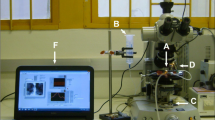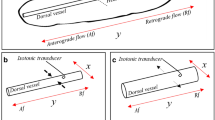Abstract
Insects have been often used as experimental animal models because of their considerable genetic homology with humans, short lifespan and low-cost maintenance. This study aims to estimate hemodynamic parameters (both systolic and the cardiac output) in response to increase in heart rate in the perfused in situ cardiac tube of the mealworm beetle Tenebrio molitor using a software developed in our laboratory, in which the heart is modeled as a prolate spheroid. A negative relationship between rate and the systolic parameters (e.g., stroke volume and ejection fraction) was observed, but the cardiac output was not statistically affected by heart rate. Considering that the end-diastolic volume was not significantly changed by rate, the negative staircase cannot be attributed mostly to the heterometric (Frank-Starling) regulation of cardiac systolic force.
Access this chapter
Tax calculation will be finalised at checkout
Purchases are for personal use only
Similar content being viewed by others
References
Stork, N.E.: How many species of insects and other terrestrial arthropods are there on Earth? Annu. Rev. Entomol. 63(1), 31–45 (2018). https://doi.org/10.1146/annurev-ento-020117-043348
Wolf, M.J.: Modeling dilated cardiomyopathies in Drosophila. Trends Cardiovasc. Med. 22(3), 55–61 (2012). https://doi.org/10.1016/j.tcm.2012.06.012
Johnson, E., Sherry, T., Ringo, J., Dowse, H.: Modulation of the cardiac pacemaker of Drosophila: cellular mechanisms. J. Comp. Physiol. B Biochem. Syst. Environ. Physiol. 172(3), 227–236 (2002). https://doi.org/10.1007/s00360-001-0246-8
Pauls, D., Blechschmidt, C., Frantzmann, F., el Jundi, B., Selcho, M.: A comprehensive anatomical map of the peripheral octopaminergic/tyraminergic system of Drosophila melanogaster. Sci. Rep. 8(1), 11–14 (2018). https://doi.org/10.1038/s41598-018-33686-3
Ranson, D.C., Ayoub, S.S., Corcoran, O., Casalotti, S.O.: Pharmacological targeting of the GABAB receptor alters Drosophila’s behavioural responses to alcohol. Addict. Biol. 25(2), 1–9 (2019). https://doi.org/10.1111/adb.12725
Bushnell, P.J., et al.: Genetic targets of acute toluene inhalation in Drosophila melanogaster. Toxicol. Sci. 156(1), 230–239 (2017). https://doi.org/10.1093/toxsci/kfw243
Mikulak, E., Gliniewicz, A., Przygodzka, M., Solecka, J.: Galleria mellonella L. as model organism used in biomedical and other studies. Przegl. Epidemiol. 72(1), 57–73 (2018)
Soumya, M., Reddy, H.A., Nageswari, G., Venkatappa, B.: Silkworm (Bombyx mori) and its constituents: a fascinating insect in science and research. J. Entomol. Zool. Stud. 5(5), 1701–1705 (2017)
Stankiewicz, M., Dąbrowski, M., Lima, M.E.: Nervous system of Periplaneta americana cockroach as a model in toxinological studies: a short historical and actual view. J. Toxicol. 2012, 1–11 (2012). https://doi.org/10.1155/2012/143740
Chowanski, S., Rosinski, G.: Myotropic effects of cholinergic muscarinic agonists and antagonists in the beetle. Curr. Pharmac. Biotechnol. 18(3), 1088–1097 (2017). https://doi.org/10.2174/1389201019666180124233440
Wang, X., et al.: The locust genome provides insight into swarm formation and long-distance flight. Nat. Commun. 5(1), 2957 (2014). https://doi.org/10.1038/ncomms3957
Adamski, Z., et al.: Beetles as model organisms in physiological, biomedical and environmental studies: a review. Front. Physiol. 10, 319 (2019). https://doi.org/10.3389/fphys.2019.00319
Viswanathan, M.C., Kaushik, G., Engler, A.J., Lehman, W., Cammarato, A.: A Drosophila melanogaster model of diastolic dysfunction and cardiomyopathy based on impaired troponin-T function. Circ. Res. 114(2), 6–17 (2014). https://doi.org/10.1161/CIRCRESAHA.114.302028
Fim Neto, A., Bassani, R.A., Oliveira, P.X., Bassani, J.W.M.: Sources of Ca2+ for contraction of the heart tube of Tenebrio molitor (Coleoptera: Tenebrionidae). J. Comp. Physiol. B Biochem. Syst. Environ. Physiol. 188(6), 929–937 (2018). https://doi.org/10.1007/s00360-018-1183-0
Feliciano, DF., Bassani, RA., Oliveira, PX., Bassani, JWM.: Pacemaker activity in the insect (T. molitor) heart: role of the sarcoplasmic reticulum. Am. J. Physiol.—Regul. Integr. Comp. Physiol. 301(6), 1838–184 (2011). https://doi.org/10.1152/ajpregu.00089.2011
Markou, T., Theophilidis, G.: The pacemaker activity generating the intrinsic myogenic contraction of the dorsal vessel of Tenebrio molitor (Coleoptera). J. Exp. Biol. 203(22), 3471–3483 (2000)
Pacholska-Bogalska, J., Szymczak, M., Marciniak, P., Walkowiak-Nowicka, K., Rosiński, G.: Heart mechanical and hemodynamic parameters of a beetle, Tenebrio molitor, at selected ages. Arch. Insect Biochem. Physiol. 99(1), 1 (2018). https://doi.org/10.1002/arch.21474
Lakatta, E.G.: Starling’s law of the heart is explained by an intimate interaction of muscle length and myofilament calcium activation. J. Am. Coll. Cardiol. 10(5), 1157–1164 (1987). https://doi.org/10.1016/S0735-1097(87)80361-3
Endoh, M.: Force-frequency relationship in intact mammalian ventricular myocardium: physiological and pathophysiological relevance. Eur. J. Pharmacol. 500(1–3), 73–86 (2004). https://doi.org/10.1016/j.ejphar.2004.07.013
Koch-Weser, J., Blinks, J.R.: The influence of the interval between beats on myocardial contractility. Pharmacol. Rev. 15, 601–652 (1963)
Mulieri, L.A., Hasenfuss, G., Leavitt, B., Allen, P.D., Alpert, N.R.: Altered myocardial force-frequency relation in human heart failure. Circulation 85(5), 1743–1750 (1992). https://doi.org/10.1161/01.CIR.85.5.1743
Antoons, G., Mubagwa, K., Nevelsteen, I., Sipido, K.R.: Mechanisms underlying the frequency dependence of contraction and [Ca2+]i transients in mouse ventricular myocytes. J. Physiol. 543(3), 889–898 (2002). https://doi.org/10.1113/jphysiol.2002.025619
Dibb, K.M., Eisner, D.A., Trafford, A.W.: Regulation of systolic [Ca2+]i and cellular Ca2+ flux balance in rat ventricular myocytes by SR Ca2+, L-type Ca2+ current and diastolic [Ca2+]i. J. Physiol. 585(2), 579–592 (2007). https://doi.org/10.1113/jphysiol.2007.141473
Bassani, R.A., Ricardo, R.A., Bassani, J.W.M.: The mechanism of negative staircase in rodent myocardium. In: 16th Symposium on Ca2+-Binding Proteins and Ca2+ Function in Health and Disease, p. 1. Annals, Pucón, Chile (2009)
Shiels, H.A., Vornanen, M., Farrell, A.P.: The force–frequency relationship in fish hearts: a review. Comp. Biochem. Physiol. Part A Mol. Integr. Physiol. 132(4), 811–826 (2002). https://doi.org/10.1016/S1095-6433(02)00050-8
Balcazar, D., et al.: SERCA is critical to control the Bowditch effect in the heart. Sci. Rep. 8(1), 1–8 (2018). https://doi.org/10.1038/s41598-018-30638-9
Acknowledgment
The technical support of Ms. Elizângela S. Oliveira is greatly appreciated. Financial support: Brazilian National Council for Scientific and Technological Development - CNPq (304010/2016-2 grant to JWMB and scholarship, for FHKI, 127197/2021-4); Brazilian Ministry of Health/FINEP (grant# 01-13-0214-00); and Coordination for the Improvement of Higher Education Personnel (CAPES, scholarships for NCBC and ARS).
Author information
Authors and Affiliations
Corresponding author
Editor information
Editors and Affiliations
Rights and permissions
Copyright information
© 2024 The Author(s), under exclusive license to Springer Nature Switzerland AG
About this paper
Cite this paper
Inazumi, F.H.K., Calderon, N.C.B., Santana, A.R., Bassani, R.A., Bassani, J.W.M. (2024). Estimation of Cardiac Output in Insect Hearts Paced at Different Rates. In: Marques, J.L.B., Rodrigues, C.R., Suzuki, D.O.H., Marino Neto, J., García Ojeda, R. (eds) IX Latin American Congress on Biomedical Engineering and XXVIII Brazilian Congress on Biomedical Engineering. CLAIB CBEB 2022 2022. IFMBE Proceedings, vol 98. Springer, Cham. https://doi.org/10.1007/978-3-031-49401-7_56
Download citation
DOI: https://doi.org/10.1007/978-3-031-49401-7_56
Published:
Publisher Name: Springer, Cham
Print ISBN: 978-3-031-49400-0
Online ISBN: 978-3-031-49401-7
eBook Packages: EngineeringEngineering (R0)




